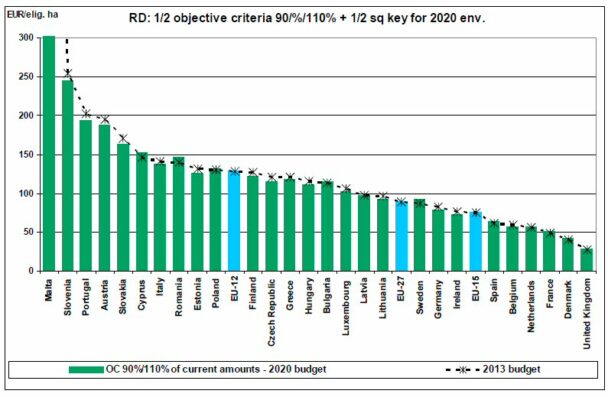There has been much interest in the provenance of the figures on the allocation of rural development funding between member states which I discussed in this post earlier this week. In the post I said that these were figures circulated by Herman van Rompuy during the special European Council meeting to discuss the MFF on November 22-23. Having spoken with some people who were present at the Council meeting I can now confirm that Van Rompuy did not circulate these figures at that meeting. I believe the figures were prepared by well-placed sources but they are not official figures and I regret any confusion which my incorrect assignation may have caused.
Thus the proposed allocation remains unknown at this point in time, beyond the reference in the draft Council conclusions that the allocation will be based on objective criteria and past performance as well as well as specific allocations to five member states.
These criteria still leave large scope for massaging the figures – which objective criteria will be used and how will they be weighted? What will be the relative weight on objective criteria and past performance, and will these weights change over time (arguably, by analogy with the dynamic hybrid model for direct payments, the weight given to past performance might be expected to diminish over time although changing annual RD allocations could complicate the design of rural development programmes)?
How will past performance be measured, on the basis of relative shares over the 2007-2013 period or, as seems more likely and used in the Commission’s impact assessment, on the basis of relative shares in 2013 alone (this matters because rural development spending in some member states was boosted towards the end of the period due to modulation of Pillar 1 payments and transfers from CMO funds)? Indeed, it seems likely that the special allocations to some member states are intended to redress their relatively disadvantaged position due to the use of 2013 shares.
A key question is how much redistribution away from current allocations will be proposed/agreed. The figures I quoted in the previous post imply a significant relative redistribution between member states (largely, but not only, from new to old member states). Perhaps the new member states may feel it is more important to defend their shares under the cohesion policy, particularly as some of them have had difficulty in drawing down their assigned rural development funds in the current programming period.
In the Commission’s impact assessment, an option examined by the Commission was to apply a ‘tunnel’ to the changes emerging from the use of objective criteria, limiting losses to 90% and gains to 110% of the previous allocation. The resulting graph (which I reproduce below) shows how closely the resulting distribution would reflect the 2013 distribution. However, there is no reference in the draft Council conclusions to any such smoothing mechanism.
We are in the second phase of negotiating the MFF at the European Council without any formal proposal as yet on the division of rural development spending. This seems to imply that rural development spending will be the ‘balancing item’ used to sweeten member states in order to reach agreement on the overall package.
If the allocation formula was based on a fixed distribution key, the absence of agreement on the overall total for Pillar 2 spending in the MFF would not be an obstacle to publishing the key. The allocation of specific amounts (in absolute terms) to five member states even before the overall ceiling for Pillar 2 spending is agreed seems to be further evidence that the allocation will be determined by political bargaining rather than some assessment of needs and value for money for the European taxpayer.
photo credit: Nicholas_T via photopin cc


